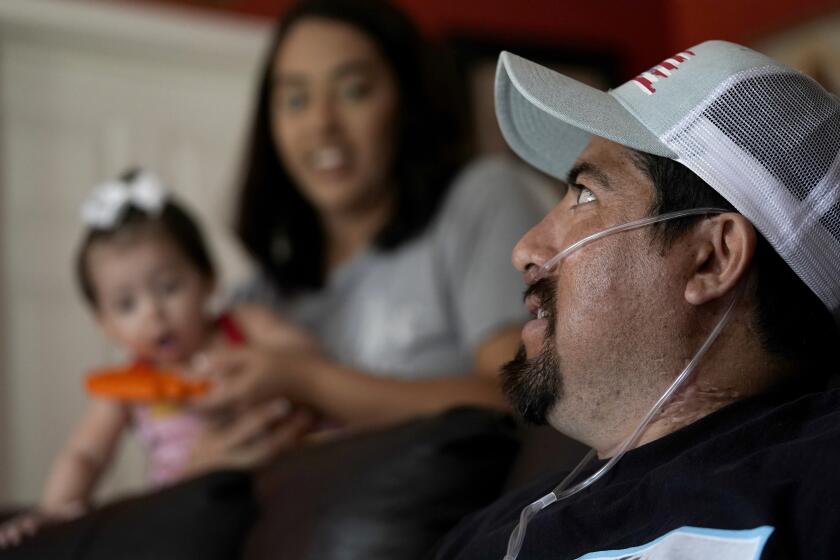Fears of more long COVID, a ‘mass disabling event’ as variants rip through California

- Share via
As highly infectious Omicron subvariants continue to fuel a new coronavirus wave, there is growing concern about long COVID, in which symptoms or increased risk of illness can persist for months or even years.
Efforts to understand the scale of long COVID’s effects have taken on additional urgency given the number of people who have come down with the virus since Omicron was first detected in California shortly after Thanksgiving. Some experts think this latest surge may exceed the record-high case counts seen over the fall and winter, leaving more people at risk of developing the condition.
“Because of the sheer volume of people that were infected, we can expect to see more long COVID cases,” said Dr. Anne Foster, vice president and chief clinical strategy officer for the University of California Health system.
For these long-haul sufferers, maladies such as a cough, chest pain, shortness of breath, heart palpitations and brain fog have marred their lives and sometimes made it impossible to work. The most enduring cases can trace their initial coronavirus infection as far back as 2020, from the beginning of the pandemic.
Vaccinations and boosters may help reduce the risk of long COVID, but at least one study suggests the protective effect could be relatively limited. That’s why, officials and experts say, it remains important to take reasonable steps to avoid infection.
It’s hard to predict the prevalence of long COVID, given the lack of a uniform definition, its sweeping array of symptoms and no easy way to test for it. Different studies have placed the percentage of people reporting symptoms for 12 weeks after an initial infection at anywhere from 3% to 50%.
But there is agreement among a number of experts that its consequences can be significant, including an increase in the risk of death or problems with other organ systems — including the heart — long after an acute infection has cleared.
An estimated 1 in 13 adults nationwide, and 1 in 14 in California, had current long COVID symptoms in early July, according to data collected by the Census Bureau and analyzed by the U.S. Centers for Disease Control and Prevention. The condition in that study was defined as someone having symptoms lasting three months or longer that weren’t experienced prior to infection.
About 1 in 7 adults across the U.S., and 1 in 8 in California, reported ever having long COVID symptoms, the data showed. As of early June, adults in their 50s were three times as likely to report long COVID than those 80 or older.
Long COVID has resulted in a “mass disabling event,” Foster said.
Loss of smell is a common symptom of COVID-19, and about 10% of patients suffer from long-term smell dysfunction. Can the nose be retrained to detect odors correctly?
“The good news is that most long COVID will resolve, let’s say, after a year. … But there’s going to be some smaller subset that will have lifelong disability and impact to their health,” Foster added.
Among those is Hannah Davis, a co-founder of the Patient-Led Research Collaborative that focuses on long COVID.
Davis got COVID-19 in March 2020 and to this day has “difficulty driving, reading and walking, and I still have not recovered,” she told the U.S. House Select Subcommittee on the Coronavirus Crisis during a recent hearing.
“Long COVID must be considered in every step of the COVID response,” she said. “It has already impacted our workforce. Many people with long COVID can’t work or need reduced hours and struggle to apply for disability benefits. The financial impact is devastating and cannot be overstated.”
The condition, she added, will “disable a huge percentage of our society if we do not decrease new cases and prioritize a cure for existing ones.”
Doctors caution that rest is an important part of weathering a COVID-19 infection.
A report published by the CDC in May estimated that 1 in 5 adults ages 18 to 64 who had COVID-19 suffered a health condition that might be related to the previous coronavirus infection. Problems can affect the lungs, heart, brain, kidneys, muscles and bones.
“The more severe the acute infection, the more likely the risk of long COVID,” said Dr. Steven Deeks, a professor of medicine at UC San Francisco and principal investigator of the Long-term Impact of Infection with Novel Coronavirus, or LIINC, study. “But it’s not absolute, and people who are not particularly symptomatic — and people who were even asymptomatic — can go on to develop long COVID, no question about it.”
Researchers are still trying to understand the cause of long COVID symptoms. Theories include that the coronavirus might cause tissue destruction during an acute infection, leading to longer-lasting illness; that the virus persists in the body even after someone is no longer infectious; that the virus revs up the body’s immune response, causing harmful inflammation; that infection triggers the development of antibodies that attack a person’s tissues; or that infection leads to blood-clotting issues.
“It’s such a diverse condition that there probably are multiple different processes or causes for some of the different types of symptoms rather than one unifying disease process,” said Dr. Lucy Horton, an infectious disease specialist at UC San Diego Health.
With the ability of the coronavirus — officially called SARS-CoV-2 — to get into the bloodstream, it’s thought that infection can provoke more inflammation, which can lead to further disease elsewhere in the body, said Dr. Ziyad Al-Aly, a clinical epidemiologist at Washington University in St. Louis and chief of research and development at the Veterans Affairs St. Louis Healthcare System.
“The common thread here is that long COVID is real,” Al-Aly said. “People are getting diabetes and heart disease and kidney disease and … it’s certainly the result of SARS-CoV-2,” which can interact with other cells and lead to organ dysfunction.
Some factors that put patients at higher risk of long COVID include being overweight, high blood pressure or heart disease, said Dr. Nisha Viswanathan, director of the UCLA Health Long COVID Program. Women also appear to be at a relatively higher risk.
It’s too early to say for sure, but many doctors believe it’s possible to suffer long-term effects from the Omicron variant of the coronavirus.
Often, underlying medical issues can become uncontrolled after a COVID-19 infection. But even those with no health problems still have some risk.
“There are many patients with long COVID who are young and had no preexisting health conditions prior to being infected with COVID,” Horton said. “We know that children can develop long COVID. So I think anyone who says COVID only affects old, unhealthy people is just ignoring the truth, to be honest.”
At UCLA, Viswanathan has an entire group of long COVID patients in their 20s who have no prior history of medical conditions and who “weren’t terribly unwell when they had COVID, either.”
Surprisingly, some now struggling most with fatigue are marathon runners, cyclists and others who, before they were initially infected, “did quite a bit of cardio exercise,” Viswanathan said.
Vaccinations and boosters are believed to be helpful at staving off long COVID, but there is no consensus on the degree to which they provide protection.
One report observing triple-vaccinated Italian healthcare workers who weren’t hospitalized for COVID-19 found that two or three doses of vaccine was associated with a lower prevalence of long COVID.
Another study, which Al-Aly co-authored and involved on U.S. veterans, found that being vaccinated brought only a 15% reduction in the odds of developing long COVID compared with unvaccinated people.
While more than 1 million people in the U.S. have died from COVID, many more have survived ICU stays that have left them with a host of health issues.
Other long COVID symptoms include worsening depression, anxiety and neuropathy, which causes pain in various parts of the body, according to Viswanathan. Patients can have isolated symptoms or a combination of any, and treatment plans need to be tailored accordingly, she said.
Symptoms also can include loss of smell or hair, ejaculation difficulty and reduced libido, according to a report published Monday in the journal Nature Medicine.
Some patients with professional degrees who had previously been high functioning are now “struggling to work,” Viswanathan said. “We’re talking about patients, who because of the brain fog, because of the fatigue, they either have really substantially decreased their work hours, or they’re completely on disability at this point.”
She said most of her patients see some degree of improvement in symptoms, with some more dramatic than others. But it takes work to develop a plan — “there’s no FDA-approved therapy for long COVID at this point,” so treatment ideas include using what’s known about other medical conditions.
For instance, those with persistent shortness of breath might undergo pulmonary rehabilitation, which is typically used for patients with asthma and chronic obstructive pulmonary disease. In some instances, physical therapy and acupuncture have helped patients with muscle pain.
And some have seen improvements by going on an anti-inflammatory diet — with lower portions of refined carbohydrates and red meat — which is otherwise suggested to reduce the risk of heart attacks and heart disease.
Sometimes, improving sleep quality helps. “For some patients, it’s literally a matter of they just need to take time off for work ... time to rest,” Viswanathan said, which gives “the opportunity for their body to probably start focusing on healing itself.”
More than a year after he was infected with the coronavirus, 14-year-old Ami Korn, who now lives in Georgia, is still struggling to fully recover.
In some cases, antidepressants (even when given to those who do not suffer from depression) can help clear brain fog, Viswanathan said, suggesting the condition may be caused by a hormonal imbalance in the brain. Other times, patients must learn how to live with brain fog, such as making lists, pacing themselves and letting others know of plans.
Some studies have shown how the coronavirus “is effectively attacking your frontal part of your brain,” Viswanathan said, and there have been autopsies of COVID-19 patients showing brain damage.
“The thing with long COVID is we have no way of knowing what is now going to happen going forward. Will [our patients’] brains heal with time? Will they not?” Viswanathan asked.
There are other viral illnesses that produce a post-viral fatigue syndrome, such as infectious mononucleosis, often referred to as mono, which is more commonly caused by the Epstein-Barr virus. Most people usually feel better within weeks, but occasionally fatigue can persist for six months or a year.
Researchers are getting serious about understanding a disease patients call “long COVID.” Its symptoms include aches, fatigue, sleep problems and brain fog.
While there are a number of different risk factors, the only surefire way to dodge long COVID is to avoid getting infected with the coronavirus.
“Even though I think many people are kind of under a delusion that the pandemic is over, it’s not,” Horton said. “So I think it’s a good time to kind of go back to our basics that have protected us: masking when in crowded indoor settings, using rapid testing before visiting older vulnerable people or groups,” and staying up to date on vaccinations.
Although it can be disconcerting that so many questions about long COVID remain, the uncertainty is not new as the virus and the science behind it have continued to evolve throughout the pandemic.
“Every time we think we’ve got this virus figured out, it basically laughs at us,” Deeks said. “It moves on, it changes, and then we have new riddles to try and figure out. And that’s the story of COVID for the last 2½ years. As they say: The virus is not done with us yet.”
More to Read
Sign up for Essential California
The most important California stories and recommendations in your inbox every morning.
You may occasionally receive promotional content from the Los Angeles Times.





















